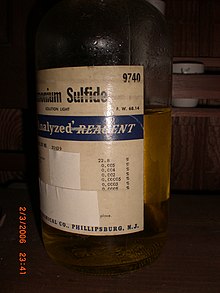Ammonium hydrosulfide
| |||

| |||
| Names | |||
|---|---|---|---|
| IUPAC name
ammonium hydrosulfide
| |||
| Other names
ammonium bisulfide
ammonium hydrogen sulfide | |||
| Identifiers | |||
3D model (JSmol)
|
|||
| ChemSpider | |||
| ECHA InfoCard | 100.031.974 | ||
| EC Number |
| ||
PubChemCID
|
|||
| RTECS number |
| ||
| UNII | |||
| UN number | 2683 | ||
CompTox Dashboard(EPA)
|
|||
| |||
| |||
| Properties | |||
| [NH4]SH | |||
| Molar mass | 51.111 g/mol | ||
| Appearance | Yellow-orange fuming liquid (in solution). White rhombic crystals (anhydrous).[1] | ||
| Density | 1.17 g/cm3[1][2] | ||
| Boiling point | 56.6 °C (133.9 °F; 329.8 K) | ||
| Miscible | |||
| Solubility | soluble inalcohol,liquidammonia,liquidhydrogen sulfide;insoluble inbenzene,hexaneandether | ||
Refractive index(nD)
|
1.74 | ||
| Hazards | |||
| Occupational safety and health(OHS/OSH): | |||
Main hazards
|
Toxic | ||
| GHSlabelling: | |||
 
| |||
| Danger | |||
| H314,H400. | |||
| P260,P264,P273,P280,P301+P330+P331,P303+P361+P353,P304+P340,P305+P351+P338,P310,P321,P363,P391,P405,P501 | |||
| NFPA 704(fire diamond) | |||
| Lethal doseor concentration (LD, LC): | |||
LD50(median dose)
|
168 mg/kg (rat, oral)[3] | ||
| Related compounds | |||
Otheranions
|
Ammonia solution | ||
Othercations
|
Sodium hydrosulfide | ||
Except where otherwise noted, data are given for materials in theirstandard state(at 25 °C [77 °F], 100 kPa).
| |||
Ammonium hydrosulfideis thechemical compoundwith theformula[NH4]SH.
Composition[edit]
It is thesaltderived from theammoniumcationand thehydrosulfideanion.The salt exists as colourless, water-soluble,micaceouscrystals. On Earth the compound is encountered mainly as a solution, not as the solid, but[NH4]SHice is believed to be a substantial component of the cloud decks of the gas-giant planetsJupiterandSaturn,with sulfur produced by itsphotolysisresponsible for the color of some of those planets' clouds. It can be generated by mixinghydrogen sulfideandammonia.
Preparation[edit]
Solutions of ammonium hydrosulfide can be prepared by passinghydrogen sulfidegas through concentratedammoniasolution.[4]According to a detailed 1895 report, hydrogen sulfide reacts with concentrated aqueous ammonia solution at room temperature to give[NH4]2S·2[NH4]SH.When this species is cooled to 0 °C and treated with additional hydrogen sulfide, one obtains[NH4]2S·12[NH4]SH.[5]An ice-cold solution of this substance kept at 0 °C and having hydrogen sulfide continually passed through it gives the hydrosulfide.
The common "stink bomb"consists of an aqueous solution of ammonium sulfide. The mixture easily converts toammoniaandhydrogen sulfidegases. This conversion illustrates the ease of the following equilibrium:
- [NH4]SH ⇌ NH3+ H2S
Ammonia and hydrogen sulfide each have a powerful and unpleasant smell.
Solid ammonium hydrosulfide can be produced by reacting an equimolar mixture of ammonia and hydrogen sulfide under -18 °C:[6]
- NH3+ H2S → NH4SH
"Ammonium sulfide"[edit]

Aqueous solutions ofammonium sulfide(CAS registry number12135-76-1), also known asdiammonium sulfideare commercially available, although the composition of these solutions is uncertain as they could consist of a mixture of ammonia and[NH4]SH.Ammonium sulfide solutions are used occasionally inphotographic developing,to applypatinatobronze,and intextilemanufacturing. It can be used as a selective reducing agent (cf.2,4-dinitrochlorobenzene); where there are two nitro groups, only one of them is selectively reduced.
The 1990–91CRC Handbook of Chemistry and Physicsgives information for anhydrous ammonium monosulfide ([NH4]2S) and ammonium pentasulfide ([NH4]2S5) as separate from anhydrous ammonium hydrosulfide ([NH4]SH), describing the former two both as yellow crystalline substances that are soluble in cold water and alcohol, and which both decompose in hot water or at high temperature in general (115 °C for the pentasulfide), but the latter as a white crystalline solid (which also decomposes in hot water).[1]Thus, it seems that solid ammonium sulfide can be distinct from solid ammonium hydrosulfide, even if this is not true in aqueous solution.
References[edit]
- ^abcLide, David R., ed. (1990). "Physical Constants of Inorganic Compounds".CRC Handbook of Chemistry and Physics(71st ed.). CRC Press, inc. p. 4-45.
- ^Pradyot Patnaik.Handbook of Inorganic Chemicals.McGraw-Hill, 2002,ISBN0-07-049439-8
- ^Record ofammonium hydrosulfidein theGESTIS Substance Databaseof theInstitute for Occupational Safety and Health,accessed on October 22, 2010.
- ^Goodman, J. T.; Rauchfuss, T. B. (2002). "Useful Reagents and Ligands".Inorganic Syntheses.Inorganic Syntheses.Vol. 33. pp. 107–110.doi:10.1002/0471224502.ch2.ISBN978-0-471-20825-9.
- ^W. P. Bloxam (1895)."The Sulphides and Polysulphides of Ammonium".J. Chem. Soc., Trans.67:283.doi:10.1039/CT8956700277.
- ^C. D. West (1934). "The Crystal Structures of Some Alkali Hydrosulfides and Monosulfides".Zeitschrift für Kristallographie - Crystalline Materials.88(1–6): 97–115.doi:10.1524/zkri.1934.88.1.97.S2CID100849097.



